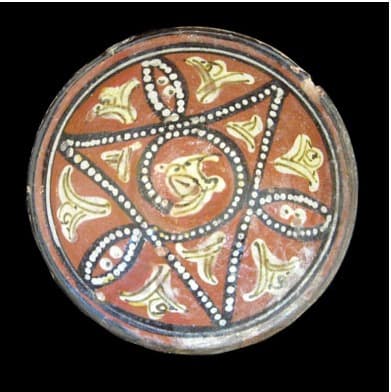Nishapur Slip Painted Bowl, 900 CE - 1000 CE
Buff Earthenware
5.1 x 1.6
AMD.0021
This exceptional bowl is made of earthenware and features a red slip with black, “yellow-staining black” and white slip painted foliage and unusual stylized triangle scroll-work decoration under a transparent...
This exceptional bowl is made of earthenware and features a red slip with black, “yellow-staining black” and white slip painted foliage and unusual stylized triangle scroll-work decoration under a transparent glaze. The beautiful contrast of the colors gives the effect of a bejeweled masterpiece replete with gold gilding. The Khalili collection has a large bowl which it attributes to the production centers of Samarqand and Transoxiana. The bowl has a similar geometric shape at the heart of its central medallion. (Earnst J. Grube, Cobalt and Lustre, Bowl 109. Accession No. POT805).
Based on the distinctive vivid colors, style and design of this outstanding bowl, we can attribute it to originating from Nishapur, eastern Iran. (See Charles K.Wilkinson, Nishapur: Pottery of the Early Islamic Period, Metropolitan Museum of Art, New York,1973; ch.5 nos 19-23). The use of the “yellow-staining black” pigment also allies it to another Nishapuri ware (Section Gd). The simple but effective repetitive design and the use of dotted bands anticipate later regional Iranian slipwares, particularly Sari ware.
For other comparable pieces see Oliver Watson, Ceramics from Islamic Lands, cataloging the Al-Sabah Collection in the Kuwait National Museum, 2004. Cat. GB.14 Bowl.
Also, Geza Fehervari, Ceramics of the Islamic World in the Treq Rajab Museum, No.60. CERII9TS
Based on the distinctive vivid colors, style and design of this outstanding bowl, we can attribute it to originating from Nishapur, eastern Iran. (See Charles K.Wilkinson, Nishapur: Pottery of the Early Islamic Period, Metropolitan Museum of Art, New York,1973; ch.5 nos 19-23). The use of the “yellow-staining black” pigment also allies it to another Nishapuri ware (Section Gd). The simple but effective repetitive design and the use of dotted bands anticipate later regional Iranian slipwares, particularly Sari ware.
For other comparable pieces see Oliver Watson, Ceramics from Islamic Lands, cataloging the Al-Sabah Collection in the Kuwait National Museum, 2004. Cat. GB.14 Bowl.
Also, Geza Fehervari, Ceramics of the Islamic World in the Treq Rajab Museum, No.60. CERII9TS
1
of
34
